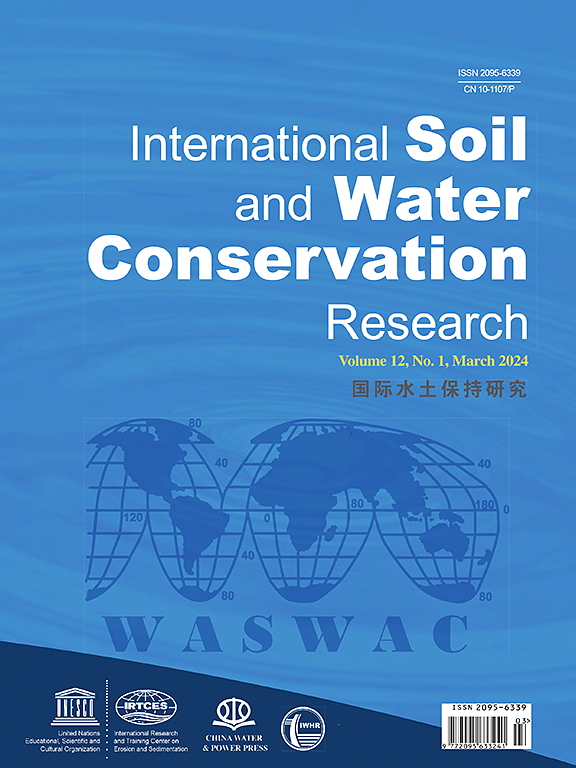Non-consistent changes and drivers of water-sediment fluxes in the yarlung tsangpo river basin of the Tibetan plateau
IF 7.3
1区 农林科学
Q1 ENVIRONMENTAL SCIENCES
International Soil and Water Conservation Research
Pub Date : 2024-10-17
DOI:10.1016/j.iswcr.2024.10.003
引用次数: 0
Abstract
Variations in water-sediment fluxes and their driving mechanisms are critical to riverine ecosystems and management. Yet, current estimates of the response of water and sediment flux remain insufficiently quantified, limited by the scarcity of long-term hydrological records in the alpine regions. Here, we leverage decadal observations in the Yarlung Tsangpo River basin, to investigate the dynamic shifts in water-sediment fluxes from 1955 to 2020 and elucidate their linkage to a warming and wetting climate, snowmelt, and environmental greening (including natural- and human-induced greening) in the different spatial and temporal scale. Major drivers of shifts in water-sediment flux are identified by using wavelet coherence and variance partitioning of redundancy analysis. The results highlight that observational data from four gauging stations (i.e., Lhaze, Nugesha, Yangcun, and Nuxia) uncover a substantial decrease in Suspended Sediment Load (SSL) (Nuxia: 12.302 × 104 t/yr, P < 0.05) in the downstream with consistently increasing runoff and precipitation. Especially during the flood season (July to September), the dam/reservoir construction caused a median decrease in SSL. Dropping sediment offsets the slightly rising SSLs in the midstream and upstream (upper Yangcun: 14.8 × 104 t/yr, P > 0.05). Up to 80% of sediment was sourced from the middle stretch between Lhaze and Nugesha despite it supplied with lower regional runoff generation. Nevertheless, the downstream zone experienced the transition from a sediment source to a deposition area around 1998. We further found the negative and positive effects between water-sediment fluxes and revegetation, and demonstrated that employing NDVI to evaluate human-induced vegetation greening might overestimate the impact of ecological restoration programs on water-sediment fluxes. Attribution analysis indicates that precipitation was not the primary contributor to runoff and SSL changes in all stretches of the basin. In the upstream, temperature and associated snowmelt can be more important than precipitation. Compared to before 1998, precipitation is still the primary driver of change in downstream runoff change after 1998, whilst vegetation restoration, rather than precipitation, dominates the reduction in downstream SSL. These findings have far-reaching significance for watershed managers and decision-makers in terms of developing effective strategies for water resources and soil erosion control.

青藏高原雅鲁藏布江流域水沙通量的非一致变化及其驱动因素
水沙通量的变化及其驱动机制对河流生态系统和管理至关重要。然而,由于高山地区长期水文记录的缺乏,目前对水和沉积物通量响应的估计仍然不够量化。本文利用雅鲁藏布江流域的年代际观测资料,研究了1955 - 2020年雅鲁藏布江流域水沙通量的动态变化,并在不同时空尺度上阐明了其与气候增湿、融雪和环境绿化(包括自然和人为绿化)的联系。利用小波相干性和方差分割的冗余分析方法,确定了水沙通量变化的主要驱动因素。结果表明,拉泽、女格沙、阳村和女霞4个台站的观测数据显示,悬沙荷载(SSL)明显减少(女霞:12.302 × 104 t/yr, P <;0.05),径流和降水持续增加。特别是在汛期(7 ~ 9月),大坝/水库的建设导致了溢流的中值下降。沉积物的下降抵消了中上游略微上升的SSLs(阳村上游:14.8 × 104 t/yr, P >;0.05)。高达80%的泥沙来自拉扎兹和努格沙之间的中间地带,尽管它提供了较低的区域产流。然而,1998年前后,下游地区经历了从沉积源到沉积区的转变。研究还发现了水沙通量与植被恢复之间的正、负作用,并表明采用NDVI评价人为植被绿化可能高估了生态恢复项目对水沙通量的影响。归因分析表明,降水并不是流域各伸展段径流和SSL变化的主要贡献者。在上游,温度和相关的融雪可能比降水更重要。与1998年以前相比,1998年以后降水仍然是下游径流变化的主要驱动因素,而植被恢复而不是降水主导了下游径流变化的减少。这些发现对流域管理者和决策者制定有效的水资源和土壤侵蚀控制策略具有深远的意义。
本文章由计算机程序翻译,如有差异,请以英文原文为准。
求助全文
约1分钟内获得全文
求助全文
来源期刊

International Soil and Water Conservation Research
Agricultural and Biological Sciences-Agronomy and Crop Science
CiteScore
12.00
自引率
3.10%
发文量
171
审稿时长
49 days
期刊介绍:
The International Soil and Water Conservation Research (ISWCR), the official journal of World Association of Soil and Water Conservation (WASWAC) http://www.waswac.org, is a multidisciplinary journal of soil and water conservation research, practice, policy, and perspectives. It aims to disseminate new knowledge and promote the practice of soil and water conservation.
The scope of International Soil and Water Conservation Research includes research, strategies, and technologies for prediction, prevention, and protection of soil and water resources. It deals with identification, characterization, and modeling; dynamic monitoring and evaluation; assessment and management of conservation practice and creation and implementation of quality standards.
Examples of appropriate topical areas include (but are not limited to):
• Conservation models, tools, and technologies
• Conservation agricultural
• Soil health resources, indicators, assessment, and management
• Land degradation
• Sustainable development
• Soil erosion and its control
• Soil erosion processes
• Water resources assessment and management
• Watershed management
• Soil erosion models
• Literature review on topics related soil and water conservation research
 求助内容:
求助内容: 应助结果提醒方式:
应助结果提醒方式:


